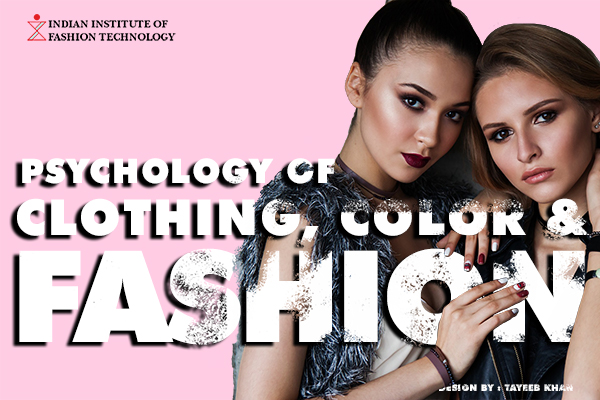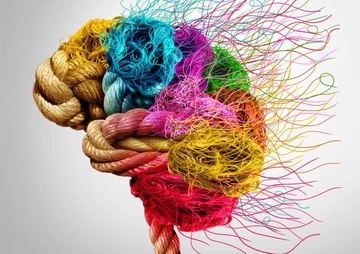
Believe it or not; psychology plays a very important role in each and every second of our lives. We as humans experience psychological phenomenons all the time; the problem is; we either don’t know about them or we just fail to notice them.
The field of Psychology is almost similar to the amount of water on earth i.e it has a role to play in each & every field in one or the other way. Also, it is one of those rare fields which has a humongous amount of specialties. Specializing in just one specialty is nothing less than a herculean task in itself.
Since you are either a Fashion Designer or an upcoming Fashion Designer getting a Diploma in Fashion Design or BSc in Fashion & Apparel Design, let’s see how psychology affects your field.
Fun Fact: There is a specialty in Psychology that deals with Fashion & Colors, it’s called the Psychology of Fashion and Psychology of Colors.
Psychologists have been doing researches over researches and performing various experiments to determine how colors affect one’s emotions & trying to figure out how the psychology of clothing works.
We will talk in detail about that, but first, let’s see where and how it all started.
It all began in the year 1826 when Charles Fredric – Arguably the first Fashion Designer Ever – set up his fashion house in the fashion capital – Paris. After that, a number of fashion houses began originating in Paris, But only during the 20th century did Fashion became a worldwide thing. A plethora of people studied it, experimented with it, researched on it(Well, they are still doing all that), and the Fashion Designing field as you know it today is the result of all those researches & experiments.
Let’s divide this post into two parts. In first, We’ll talk about the Psychology of Fashion & the Psychology of Clothing. In the latter part, We’ll briefly talk about the Psychology of Colors and what different colors signify.
Shall We Begin?
Psychology Of Fashion & Psychology Of Clothing:
If you think that the inception of Fashion Psychology was in the 20th century – I can see how you came to that conclusion – but, you can’t be more wrong. Henry James, an American psychologist was the first person to introduce the notion of Psychology in Fashion during the 19th century.
It might surprise you to know that there are some people who would go as far as to say that “Fashion is Psychology”. Maybe because of the fact that both the fields deal primarily with people, their perception, social interactions, and more. They kind of cross paths in some way or the other. That’s not it, Fashion Psychology and Psychology of marketing also interject each other at various instances.
Studies suggest that what people wear has an effect on their attitude, mood, confidence, and their overall behavior. In a way, you as a fashion designer would help someone gain confidence.
In one of the Psychological papers published by Duje KODZOMAN; He mentions that people purchase and wear clothes according to the meaning they believe those clothes to have or the messages they believe the clothes send out. He further goes on to talk about Clothing being an extended dimension of one’s bodily self.
You can use the science of Psychology to manipulate how people react to certain designs and to modify their purchase patterns so that customers would lean towards the brand you are working for. This is where the Psychology of Fashion & the Psychology of Marketing intersect.
Taking a scientific/psychological approach to Fashion will enable you to understand human behavior in the context of Fashion. Even though Fashion is a creative, glamorous & dynamic field; it’s not the one without any problems. Psychology can help you understand and solve those problems in the field.
Psychology Of Colors:

Colors have been altering our behavior for centuries now; Big brands have been using this – Psychology Of Colors – to their advantage for a really long time.
Don’t believe me? Let me prove it for you.
Have you ever noticed that most of the fast-food or food franchises like McDonald’s, KFC, etc.. incorporate red into their logos & food joints to a great deal? That’s because when you see red, it revs up your appetite & makes you feel hungry.
Still don’t believe me? here is another example for you from a brand which you use a lot.
Websites like Amazon use a dark shade of yellow (Orangish) on their “Pay Now” & “Limited Offer” buttons because the color suggests urgency and makes the message more noticeable.
You can also notice Black being used a lot in websites that deal with premium & luxury products. I hope that gives you a vivid idea about the psychology of colors.
The psychology of colors is a smaller part of Behavioral Psychology. Let me explain to you with science terms how the Psychology of colors works. When you see a color, your eyes communicate with the region of the brain known as the hypothalamus which in turn sends an avalanche of signals to the pituitary gland, onto the endocrine system & then to the thyroid glands. Thyroid glands on receiving these signals release a burst of hormones which causes the fluctuation in your mood, emotion & behavior.
If you did not understand the science part, let me put it in layman’s terms. As soon as you see a color, Your brain starts sending signals to a part and that part then releases hormones that affect your mood, emotion & behavior.
Different color has different effects on you. So, if you use the colors in your designs accordingly, you can alter how people react to your designs and the perfect use of colors would help you sell more of your designed clothes.
Let’s see what color creates what kind of effect on people.
Blue: Blue creates a sense of trust amongst people. So if you are new in the Fashion field or you are launching a new brand; using blue might help you cultivate the trust of your customers for you. Blue is also the color of peace, order & loyalty. It gives the mind a sense of calmness & serenity.
Yellow: Yellow is mostly used in warnings. But it is the color of happiness as well. But, yellow is one of those colors which has to be used very carefully. Using more of it has a history of creating a feeling of nausea among people. Hence be very aware of how much yellow you are using.
Green: The color of nature. Green relatively gains people’s attention when compared to other colors. It’s also relatively easier for people to remember something that’s green since it kind of stands out.
Orange: Orange creates a sense of impulse in people when they see it. It can be used as a fun color since it helps to stimulate physical activity & a sense of confidence. It’s also the color that depicts affordability.
However, orange can be slightly overwhelming. A research paper by Lucky Tonk advises, “Orange will be used sparingly to bring your attention to something, but not so much as to overwhelm the person looking at it.”
Black: Black has always been associated with luxury. Darker the tone of black, the more luxurious it is. Black also represents elegance, sophistication & power. Now you may realize why they wear black suites in movies like Men In Black. It’s one of my personal favorites as well. Let me know what are in the comments.
Pink: Pink is compassionate, youthful, understanding & a bit of romance. It’s a common misconception that most females like pink but the fact is that a very small percentage of females pick pink as their favorites. Most of the women according to a study likes blue.
Now let’s talk about one of the most famous colors – RED
Red is one color that signifies a boat-load of things. The funny part is, most of the things that red represents contradict each other. Red signifies romance, but it also signifies danger. If you want attention; Red is the way to go. This is a color that has to be used with utmost care.
One of the research suggests that people especially women look more attractive when they are wearing red (That might explain why girls wear red during their marriages). Red is also often associated with passion, action, and energy. Use all the red you can in your designs but dread carefully.
Use of Psychology during your designs might take you a long way as a Fashion Designer. Now that you know to some extent how the Psychology of Fashion, Clothing & Color works, start putting your knowledge to work and observe how it changes a person’s mood or behavior. Sometimes it’s so subtle that you might blink & miss it, But there will always be some effect of using psychology in your designs in all of your Fashion Designing careers.
Have questions or need links to papers on the researches mentioned above. Comment below or get in touch on the social media page & you shall receive the links to them.
